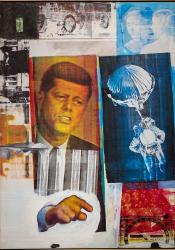Neo-Dada Movement
The terminology Neo-Dada is often used in relation to modern artists and their works, and it utilizes similar methods to those of the Dada movement that occurred from 1916-1923. The first Dada appeared in Zurich during 1916 as an anti-art movement, and it was inspired by junk art that was created by Marcel Duchamp, a modernist sculpture of Picasso, Henri Laurens, and work in relation to propaganda done by Andre Breton. The movement was a strain of avant-garde art, and it utilized unorthodox methods and materials, popular imagery, and collaborative juxtapositions. It was further driven by an anti-establishment ethic. The Neo-Dada movement continued to influence a wide variety of 20th century artists, and also contemporary art movements, with Pop Art being one that sprouted from it. Art created within the Neo-Dada style rejected elitism that was often associated with Abstract Expressionist works, and it remained in favor of a more socialist type of art, which emphasized communities and our environment. The artists often worked alongside other similar artists, poets, musicians, dancers, and other groups that resulted in a new branch of aesthetics. This movement’s interest was revived during the 1950s in America and France. The “anything goes” attitude was embraced by artists, and unorthodox materials were used to protest high art traditions. For example, Duchamp’s collage art that was done alongside Kurt Schwitters and Georges Braque and the Surrealist artist’s efforts to turn the greatness of everyday life and its objects into a shared value were important parts of inspiration for them.
Works Cited:
“Neo-Dada Art: History, Characteristics, Neo-Dadaists.” Www.visual-Arts-Cork.com, www.visual-arts-cork.com/history-of-art/neo-dada.htm. Accessed 2 Apr. 2023.
“Neo-Dada.” Wikipedia, 29 Mar. 2023, en.wikipedia.org/wiki/Neo-Dada#/media/File:Robert_Rauschenberg. Accessed 2 Apr. 2023.

